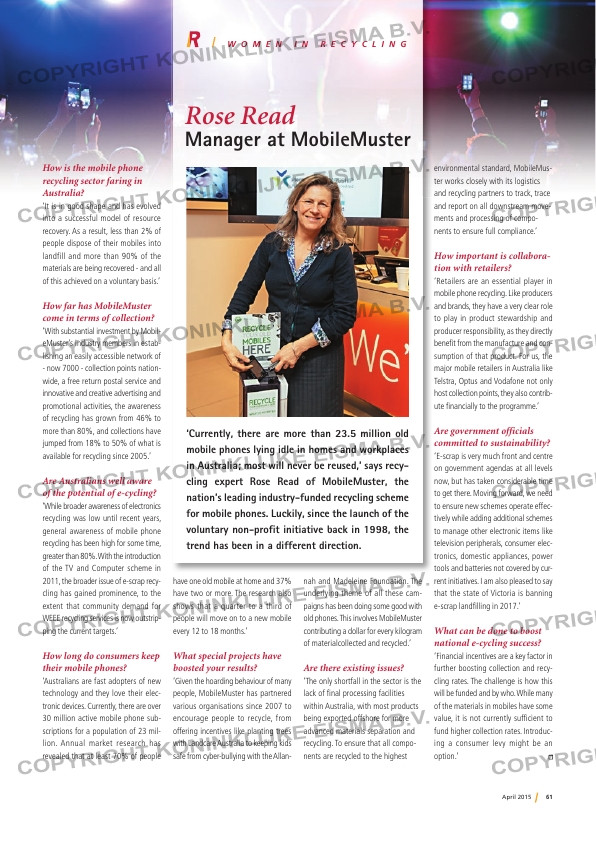Page 61 from: April 2015

61April 2015
W O M E N I N R E C Y C L I N G
How is the mobile phone
recycling sector faring in
Australia?
‘It is in good shape and has evolved
into a successful model of resource
recovery. As a result, less than 2% of
people dispose of their mobiles into
landfill and more than 90% of the
materials are being recovered – and all
of this achieved on a voluntary basis.’
How far has MobileMuster
come in terms of collection?
‘With substantial investment by Mobil-
eMuster’s industry members in estab-
lishing an easily accessible network of
– now 7000 – collection points nation-
wide, a free return postal service and
innovative and creative advertising and
promotional activities, the awareness
of recycling has grown from 46% to
more than 80%, and collections have
jumped from 18% to 50% of what is
available for recycling since 2005.’
Are Australians well aware
of the potential of e-cycling?
‘While broader awareness of electronics
recycling was low until recent years,
general awareness of mobile phone
recycling has been high for some time,
greater than 80%. With the introduction
of the TV and Computer scheme in
2011, the broader issue of e-scrap recy-
cling has gained prominence, to the
extent that community demand for
WEEE recycling services is now outstrip-
ping the current targets.’
How long do consumers keep
their mobile phones?
‘Australians are fast adopters of new
technology and they love their elec-
tronic devices. Currently, there are over
30 million active mobile phone sub-
scriptions for a population of 23 mil-
lion. Annual market research has
revealed that at least 70% of people
have one old mobile at home and 37%
have two or more. The research also
shows that a quarter to a third of
people will move on to a new mobile
every 12 to 18 months.’
What special projects have
boosted your results?
‘Given the hoarding behaviour of many
people, MobileMuster has partnered
various organisations since 2007 to
encourage people to recycle, from
offering incentives like planting trees
with Landcare Australia to keeping kids
safe from cyber-bullying with the Allan-
nah and Madeleine Foundation. The
underlying theme of all these cam-
paigns has been doing some good with
old phones. This involves MobileMuster
contributing a dollar for every kilogram
of materialcollected and recycled.’
Are there existing issues?
‘The only shortfall in the sector is the
lack of fi nal processing facilities
within Australia, with most products
being exported offshore for more
advanced materials separation and
recycling. To ensure that all compo-
nents are recycled to the highest
environmental standard, MobileMus-
ter works closely with its logistics
and recycling partners to track, trace
and report on all downstream move-
ments and processing of compo-
nents to ensure full compliance.’
How important is collabora-
tion with retailers?
‘Retailers are an essential player in
mobile phone recycling. Like producers
and brands, they have a very clear role
to play in product stewardship and
producer responsibility, as they directly
benefi t from the manufacture and con-
sumption of that product. For us, the
major mobile retailers in Australia like
Telstra, Optus and Vodafone not only
host collection points, they also contrib-
ute fi nancially to the programme.’
Are government officials
committed to sustainability?
‘E-scrap is very much front and centre
on government agendas at all levels
now, but has taken considerable time
to get there. Moving forward, we need
to ensure new schemes operate effec-
tively while adding additional schemes
to manage other electronic items like
television peripherals, consumer elec-
tronics, domestic appliances, power
tools and batteries not covered by cur-
rent initiatives. I am also pleased to say
that the state of Victoria is banning
e-scrap landfi lling in 2017.’
What can be done to boost
national e-cycling success?
‘Financial incentives are a key factor in
further boosting collection and recy-
cling rates. The challenge is how this
will be funded and by who. While many
of the materials in mobiles have some
value, it is not currently suffi cient to
fund higher collection rates. Introduc-
ing a consumer levy might be an
option.’
‘Currently, there are more than 23.5 million old
mobile phones lying idle in homes and workplaces
in Australia; most will never be reused,’ says recy-
cling expert Rose Read of MobileMuster, the
nation’s leading industry-funded recycling scheme
for mobile phones. Luckily, since the launch of the
voluntary non-profit initiative back in 1998, the
trend has been in a different direction.
Rose Read
Manager at MobileMuster



